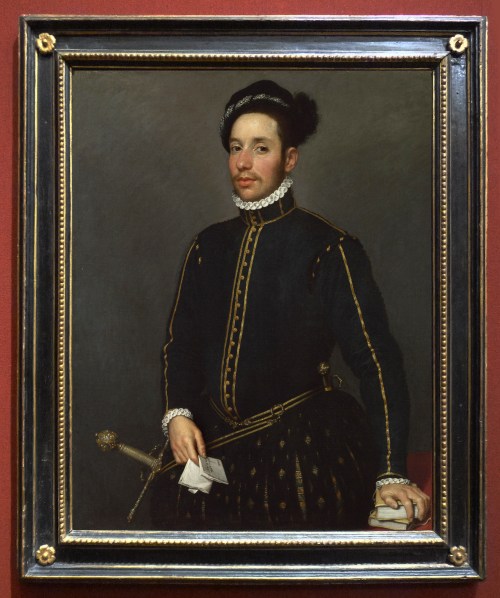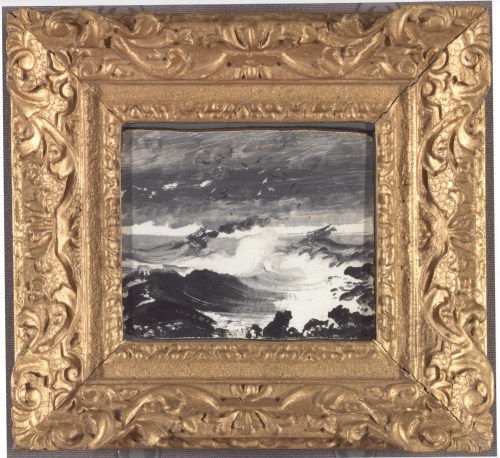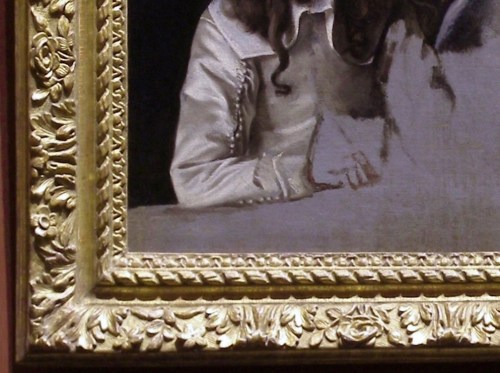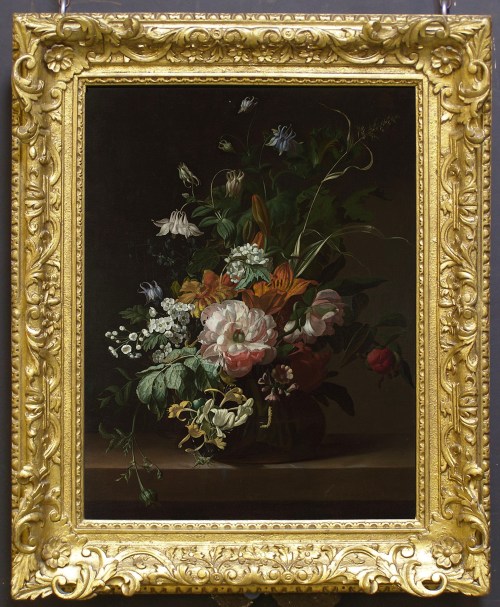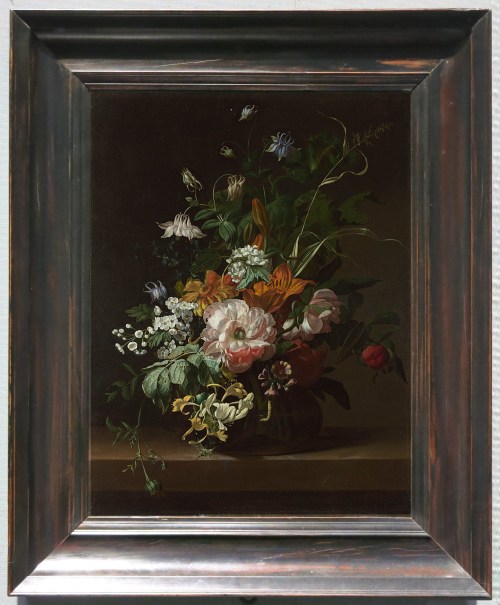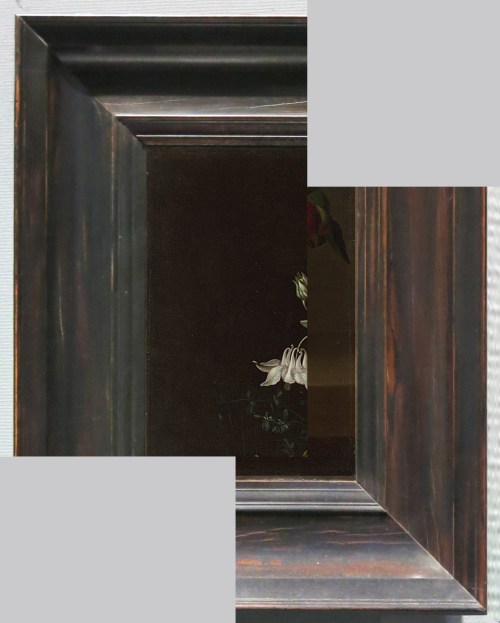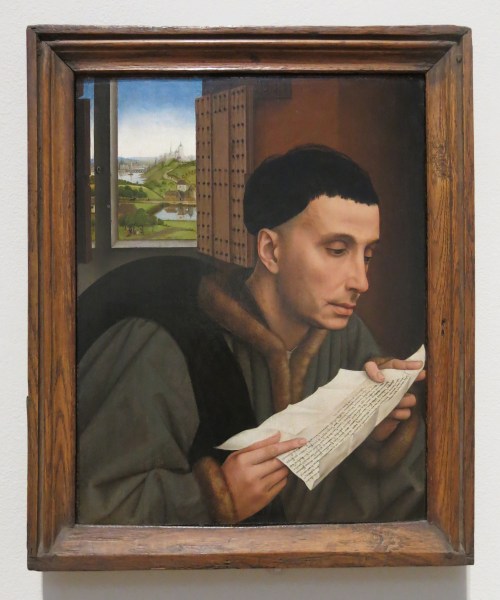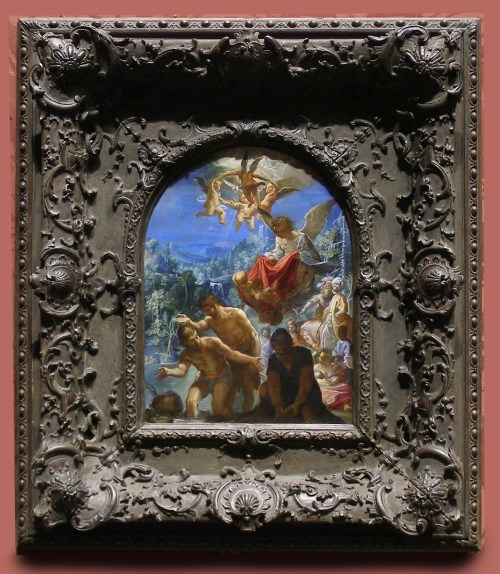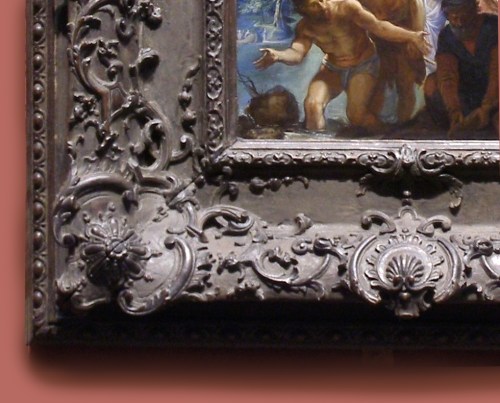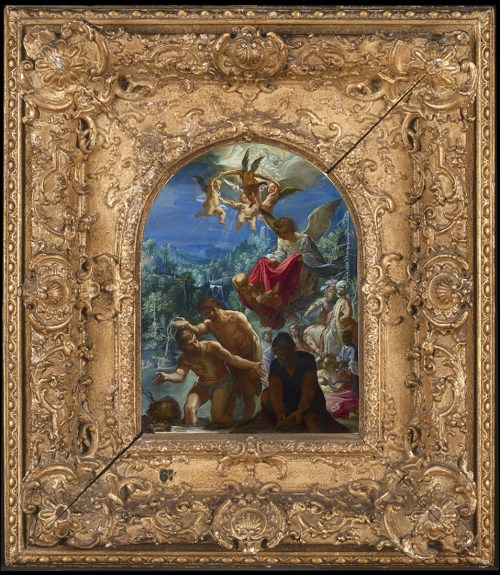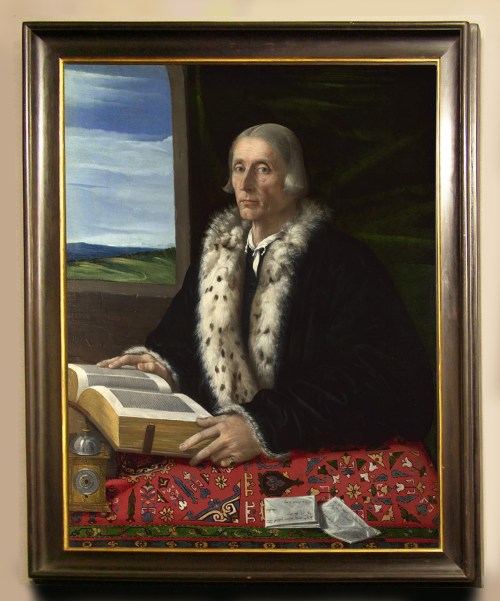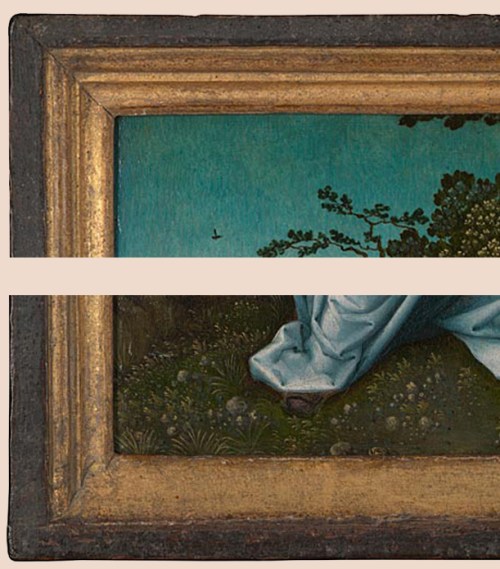Reframing at the National Gallery, London: Part 3
by The Frame Blog
This is the third of a series of short articles on the reframing projects undertaken by the National Gallery, London, under the Head of Framing, Peter Schade. The articles were originally published in the National Gallery’s Review of the Year, from 2008-09 onwards, and are republished here by kind permission of the Gallery, and with added illustrations.
3: Review of the year April 2010 – March 2011: Framing, by Peter Schade
The National Gallery has developed a variety of approaches to improve the quality of its frames. Rather than selecting a particular painting for reframing, we have been successful in locating suitable antique frames and matching them with paintings of the same period and often even of the same size. It is not possible to meet every Gallery reframing priority in this way, but there are four recent examples where available frames have been paired with suitable paintings.
Moroni
The National Gallery’s fine group of Moroni portraits had all ended up with more or less unsatisfactory frames. We made a first significant improvement in when we found a beautiful walnut cassetta for the Portrait of a lady /‘La Dama in Rosso’ (NG1023) and this year we have been able to reframe both the Portrait of a gentleman /‘Il Gentile Cavaliere’ (NG2094) and the portrait of Canon Ludovico di Terzi (NG1024).
NG 2094 Moroni (1520/4–1579), Portrait of a left-handed gentleman with two quartos and a letter (‘Il gentile cavaliere’), c.1564–5, o/c, 100.4 x 81.2 cm., in previous mid-17th century (or possibly replica) Italian reverse cassetta, carved with four orders of ornament; parcel-gilt with painted frieze; this frame was then re-used for NG 1105)
NG 2094 Moroni, Portrait of a left-handed gentleman…, reframed in a late 16th–early 17th century Italian cassetta with canted fillets and astragals on top edge; narrow, butt-jointed frieze with applied corner rosettes; beading between astragals and fillets at sight edge; painted black and polished, and picked out with parcel-gilding; and detail
This Northern Italian reverse cassetta (a frame where the inner edge is higher than the outer one) with carved and gilded ornament (rosettes at the corners and pearls at the inner edge) is contemporary with the picture. The parallels with the sitter’s dress are obvious. We would generally not seek to find frames that echo the painting, but the result here is exceptionally happy.
NG 1024 Moroni (1520/4–1579), Canon Ludovico di Terzi, c.1559–60, o/c, 101.5 x 82.7 cm., in previous late 16th–early 17th century Italian ogee bolection frame, with undulating leaf ornament applied in gesso (aggetti) between astragal-&-triple bead mouldings; modern leaf corners; regilded
 NG 1024 Moroni, Canon Ludovico di Terzi, reframed in a 16th century Italian cassetta, with stepped ogee mouldings around a narrow frieze with sgraffito inscription clockwise from top rail; painted and parcel-gilt; with details
NG 1024 Moroni, Canon Ludovico di Terzi, reframed in a 16th century Italian cassetta, with stepped ogee mouldings around a narrow frieze with sgraffito inscription clockwise from top rail; painted and parcel-gilt; with details
The cassetta with a Latin text in the frieze was relatively common in 16th century Italy and Spain. They were mostly intended for religious paintings and often refer to a particular subject, such as the Virgin and Child, or Christ on the Cross. On this frame is an inscription from Paul’s first letter to the Corinthians (I Corinthians 2: 9):
Nec auris auvidid /Nec oculus vidit /Nec in cor hominis ascendit /
Qua preperavit Deus dilligentibus se.What no ear has heard / What no eye has seen / What has not entered into the heart of men/ That God has prepared for those who love him.
The date, weight and colour of the frame suit the picture perfectly. Although the text is appropriate for a portrait of a cleric, we cannot be sure of its original application.
**********************
Garofalo
Two Italian frames from the second quarter of the 16th century were acquired for Garofalo’s Agony in the Garden (NG642) and his Holy Family (NG170). Like the two Moroni frames, both were almost exactly the right size. Uniting unaltered frames with paintings of the same period not only preserves their proportion and value, it also reduces the influence of transient contemporary aesthetic judgement on long-term framing solutions.
NG 642 Garofalo (about 1481–1559), The Agony in the Garden, probably c.1520–39, o/c, transferred from wood, 49.2 x 38.7 cm., in previous late 17th–early 18th century Italian (possibly Roman) Baroque torus frame with flowered back edge; centred spiral leave-&-stave; regilded
NG 642 Garofalo, The Agony in the Garden, reframed in 16th century Italian Renaissance reverse cassetta; wide frieze carved with scrolling palm branches holding rosettes, centred on high relief cherubs’ heads with four wings; between beading at back edge, and leaf moulding with astragal-&-double bead at sight edge; water-gilded and patinated; with details
This reverse cassetta with carved scrolling foliage centred on cherubim complements the symmetry of the painting’s composition and suits its sacred character. It is in itself an almost perfectly preserved collectable object of artistic merit, and yet it does not detract from the calm and serious tone of the picture.
NG 170 Garofalo (c.1481–1559), The Holy Family with SS John the Baptist, Elizabeth, Zacharias and (?) Francis, c.1520, o/c, 60.3 x 47.8 cm., in previous 1980s reproduction 16th century-style cassetta, with entablature profile and wide frieze with ersatz engraved polychrome floral decoration
NG 170 Garofalo, The Holy Family with saints, reframed in 16th century Italian tabernacle frame; with entablature and turned baluster columns in the Venetian style; with matching frieze and predella panels, with 5-petalled bosses, cherubim heads & panels of sgraffito foliate decoration; leaf modillions below columns; rosette bosses above; Composite columns springing from a bulb of lily leaves; apron with indented ovolo contour, scrolled with 5-petalled bosses on each side and central floral boss; gilded and polychromed; with details
This architectural tabernacle frame has beautiful sgraffito decoration on the antependium, or apron. The columns echo those in the painting, and create a space for the figures as well as greater depth for the view beyond. The stylised cherubim in the frieze and the plinth even resemble the ornament on the cradle in the picture. The purchase of this frame underlines the importance of a readily available budget for such a purpose. We have been very fortunate to have attracted individual donations for particular framing projects and hope that successful reframings at the National Gallery will attract more interest in this activity as well as much-needed financial support.
Paintings reframed in 2010–2011
Framed with newly acquired antique frames:
Peder Balke
NG 6614 Peder Balke (1804-87), The Tempest, c.1862, panel, 12 x 16.5 cm., in previous 18th century British Louis XIV-style pinewood frame; with an ogee profile and narrow frieze; flowered back edge; projecting squared shell corners, joined by S-scrolled foliate strapwork with leaf-bud centres on a textured ground; and acanthus tip sight edge; gilded, with sanded frieze
NG 6614 Balke, The Tempest, panel, 12 x 16.5 cm. including inlay; reframed in 19th–20th century British canted frame in mahogany; with reeded top edge and single oil-gilded reed at sight edge; finished in polished black paint; with detail
Philippe de Champaigne
NG 798 Philippe de Champaigne (1602-74), Triple portrait of Cardinal Richelieu, c.1642, o/c, 58.7 x 72.8 cm., in previous 19th century reproduction Netherlandish-style bolection frame, with bands of ripple moulding on the back and sight edges, and basketweave torus on the top edge; a mass-produced milled pattern, in stained and polished wood
NG 798 Champaigne, Triple portrait of Cardinal Richelieu, reframed in 17th century late Louis XIII carved oak frame with convex profile; with flowered back edge; alternating scrolling acanthus leaves with leaf buds & lilies on a cross-hatched ground with acanthus leaf corners; two small hazzled bands; acanthus leaf tip on hatched ground at sight edge; original matt and burnished gilding; with detail
Correggio
NG 4255 Correggio (fl. 1494-d.1534), Christ taking leave of his Mother, before 1514, o/c, 86.7 x 76.5 cm., in previous early 20th century reproduction 17th century-style Italian garland frame with bolection profile; with Bolognese-style half-flowers on back edge; flowers and centre clasps on fruit and foliage garland; probably carved for the donor of the painting, the dealer Joseph Duveen, possibly in Florence
NG 4255 Correggio, Christ taking leave of his Mother, reframed in late 16th century Italian cassetta (previously cut down); with wide frieze decorated with centred undulating & scrolled leaf-&-bud ornament; now slightly off-centre; original corner convergence lost at top left & bottom right; painted black and parcel-gilt; with detail
Van Gogh
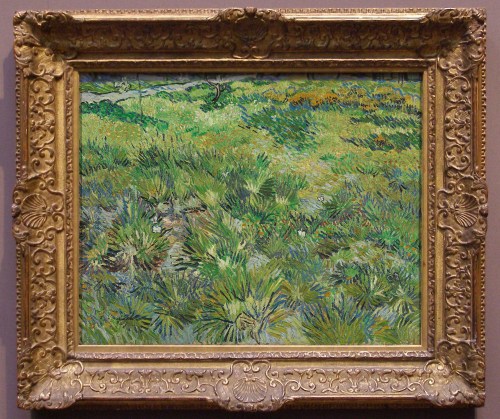
NG 4169 Van Gogh (1853-90), Long grass with butterflies, 1890, o/c, 64.5 x 80.7 cm., in previous 19th /20th century French plaster reproduction frame in 17th century Louis XIV style, with ogee profile; stopped channel fluting at back edge; projecting fanned lambrequin and scrolling foliate corners & shell centres, with diapered grounds; scrolling foliate C-scrolled strapwork & leaf buds on the ogee, with cross-hatched ground; small sanded frieze and acanthus leaf tip at sight edge; inlay
NG 4169 Van Gogh, Long grass with butterflies, 1890; reframed in 19th century French NeoClassical scotia frame, carved in oak; mostly original gilding and patination; with detail
Gossaert
NG 2211 Gossaert (fl.1508-d.1532), A young Princess (Dorothea of Denmark?), c.1530-32, o/panel, 38.2 x 29.1 cm., in previous frame late 20th century stained oak frame; architrave profile with inner deep moulding and clumsy rainsill
NG 2211 Gossaert, A young Princess (Dorothea of Denmark?), reframed in late 16th century Italian Baroque moulding frame; carved in walnut and polished, with original patina; with detail
Le Nain Brothers
NG 4857 Le Nain Brothers (c.1600-48; c.1603-48; c.1607-77), Three men and a boy, c.1647-48, o/c, 54.1 x 64.5 cm., in previous 18th century British pierced and swept Rococo frame; with corners of opposed foliate C-scrolls and applied florets on hatched ground; leaf and rocaille centres; with flat rails of S-scrolls; with leaf sprigs & florets in the hollow; engraved contour lines; small cross-hatched or hazzled frieze; lotus leaves at sight edge; with detail
NG 4857 Le Nain Brothers, Three men and a boy, reframed in 17th century French Louis XIII carved oak ogee frame; with hazzling on back edge; cross-cut acanthus alternating with roses & buds, sunflowers, violets and narcissi/asphodel, with acanthus leaf corners, on cross-hatched ground; spiral ribbon running continuously around frame; acanthus leaf-&-tongue on hatched ground at sight edge; regilded and patinated; with detail

NG 4857 Le Nain Brothers, Three men and a boy, details of flowers
The particular pattern of this Louis XIII frame, with its sprigs of accurately-carved and identifiable flowers interspersed with cross-cut acanthus leaves, might be interpreted symbolically, as well as used purely decoratively. This does not mean that it was produced to interact or expand upon the meaning of one specific painting: more that it employs flowers which might be considered appropriate in the general context of ‘painting’. Thus, it contains (as well as acanthus leaf corners = the arts), roses = beauty (top left), violets = modesty (bottom left), asphodel = Elysium or immortality (top right), and sunflowers = Apollo, god of the arts.
NG 1425 Le Nain Brothers (c.1600-48; c.1603-48; c.1607-77), A woman and five children, 1642, copper panel, 21.8 x 29.2 cm., in previous frame made in 1979 from elements of two 18th century French frames, creating a Louis XIII-style torus frame with opposed C-scrolls and florets on a diapered ground, with acanthus leaf corners; astragal-&-bead; concave acanthus leaf sight edge
NG 1425 Le Nain Brothers, A woman and five children, reframed in mid-17th century French Louis XIII oak frame with convex profile; with S-scrolled strapwork holding alternating fanned lambrequins & leaf buds with acanthus leaf corners on a cross-hatched ground; small hazzled band; centred spiral ribbon; second small hazzled band at sight edge; with detail
Eustache Le Sueur

NG 6548 Le Sueur (1616-55), Christ on the Cross with the Virgin, Mary Magdalen, & St John the Evangelist, c.1643, o/c, 109 x 73.1 cm., in previous NeoClassical entablature frame; with cross-cut acanthus leaf hollow; plain frieze; lotus leaf; beading at sight edge
NG 6548 Le Sueur, Christ on the Cross…, reframed in 17th century French Louis XIII oak frame; carved with centred garland of oak leaves & acorns, ribbon-bound at centres, with acanthus leaf corners; acanthus leaf tip sight edge; gilded; with detail
Oak leaves are appropriate for the subject, symbolizing, faith, strength & virtue, & legendarily the wood from which the Cross was made; also versions of this Louis XIII pattern were used (on a much smaller scale) for shaped frames containing carved crucifixes for domestic settings.
Judith Leyster

NG 5417 Judith Leyster (1609-60), A boy and a girl with a cat and an eel, o/panel, 59.4 x 48.8 cm., in previous late 19th century revival Louis-XIII-style reproduction bolection frame, carved with lotus leaf back edge; fluted hollow beneath the top edge; torus with spiral ribbon enriched with florets; water-gilded
NG 5417 Judith Leyster, A boy and a girl…, reframed in 17th century Netherlandish cabinetmaker’s frame, veneered in ebony and polished; with detail
Pisanello
NG 1436 Pisanello (c.1394-1455), The vision of St Eustace, c.1438-42, panel, 54.8 x 65.5 cm., in previous 19th /20th century reproduction cassetta; with wide frieze decorated in parcel-gilding and polychrome (dark blue/black, red and white) and sgraffito with vertebrate ornament, corner & centre rosettes
NG 1436 Pisanello, The vision of St Eustace, reframed in 15th century Italian ogee moulding frame, acquired as four rails disassembled from a larger panel; gilded and patinated; with detail
Rachel Ruysch
NG 6425 Rachel Ruysch (1664-1750), Flowers in a vase, c.1685, o/c, 57 x 43.5 cm., in previous early 18th century British Louis XIV-style ogee frame; with egg-&-dart on back edge; projecting corners with opposed & foliated C-scrolls with leaves and applied florets, joined by continuous scrolling foliated strapwork on the ogee, centred with sprigs of heartsease, alternating with leaf buds on the side rails; sanded frieze; fluted sight edge; brightly regilded
NG 6425 Rachel Ruysch, Flowers in a vase, reframed in 17th century Netherlandish cabinetmaker’s frame with shallow scotia profile, veneered in polished ebony; with details
Rogier van der Weyden
NG 6394 Workshop of Rogier van der Weyden (c.1399-1464), A man reading (St Ivo?), c.1450, o/panel, 45 x 35 cm., in previous 1970s reproduction architrave frame in faux early Renaissance style; with fillet, astragal and cavetto to sight edge; gilded
NG 6394 Workshop of Rogier van der Weyden, A man reading (St Ivo?), reframed in late 14th-early 15th century Northern rainsill frame in oak wood; with stylized colonet moulding and cavetto to sight on three sides; with canted sill at base; stained and polished
Frame reconstructed with newly acquired antique parts
Leonardo
NG 1093 Leonardo da Vinci (1452-1519), The Virgin of the Rocks, c.1491/92-99 & 1506-08, o/panel, 186.5 x 120 cm., in previous frame (with compo ornament): one of three reproduction Renaissance altarpiece frames made after 1880 by the firm of Reginald Dolman & Son (also for Raphael, The Ansidei Altarpiece, and Lorenzo Costa & Gianfrancesco Maineri, The Strozzi Altarpiece), and based on the main door frame of San Giobbe, Venice
NG 1093 Leonardo da Vinci, The Virgin of the Rocks, reframed in 3 elements of an antique 16th century Italian Renaissance aedicular altarpiece frame, with replica arched sight & spandrels, moulding beneath top frieze, pilaster plinths and predella constructed in the Gallery workshop; carved in walnut with acanthus-&-dart; egg-&-dart; dentils; horizontal cherub & candelabrum on top frieze; vertebrate candelabrum on pilasters; Composite capitals; enriched guilloche with acanthus spandrels at sight; horizontal vertebrate leaf on predella frieze with acanthus spandrels holding predella plinth roundels; with original water-gilding and polychromy, and replica ditto
Three sides of a 16th century aedicular Italian Renaissance frame, purchased from Cambi, Genoa, 2009
Giacomo del Maino et al., Altar of the Immaculate Conception, after 1495, San Maurizio, Ponte in Valtellina
The reconstruction of the frame was based on the sculptural Altar of the Immaculate Conception in Ponte in Valtellina, carved after 1495 by Giacomo del Maino and his workshop, from whom the original frame for The Virgin of the Rocks was commissioned (before the painting was executed) for the church of San Francesco, Milan. The San Maurizio altarpiece was very close in its structure and ornamental details to the partial 16th century aedicular frame elements purchased from Genoa, and was used to supply models for the block pilaster plinths, predella frieze, guilloche at the sight edge & acanthus leaf spandrels, as well as the roundels with acanthus spandrels in the plinths at predella level.
Corner of the entablature and ornamented frieze of the San Maurizio altarpiece (top); detail of the predella of The Virgin of the Rocks with a replica of the same ornament (bottom)
The main elements were carved, and the ornament raised by hand in pastiglia (i.e. not produced from a reverse mould), like the ornaments on the existing 16th century sections; the pastiglia had a cellulose (lavatory paper) base. The original gilding and polychromy of the Genoese frame were retained, and the new elements gilded and painted to match, following the pattern of the San Maurizio frame.
Gessoing the assembled frame elements
Framed from Gallery stock
Elsheimer
NG 3904 Elsheimer (1578-1610), Baptism of Christ, c.1599, o/copper panel, 28.1 x 21 cm., in previous 1970s reproduction frame in style approximating to a 17th century Netherlandish pattern, with scotia, canted frieze, ripple and wave mouldings; veneered in ebony and parcel-gilt (one of four of this design made for Elsheimers in the Gallery)
NG 3904 Elsheimer, Baptism of Christ, reframed in the early 18th century French Régence carved walnut frame in which it was originally acquired (and remained until 1979), commissioned for it by an 18th century collector; with arched sight; cabochon chain on back edge; corners with raised ‘doorbell’ rosettes and shell centres, held in opposed C-scrolls, linked by foliate strapwork along the top edge; with foliate buds, clasps and wings scattered on the frieze and joining the sight edge of a leaf-bud chain; stripped of later finishes, stained and patinated; with detail
NG 3904 Elsheimer, Baptism of Christ in Régence frame before restoration
The frame had initially been water-gilded over recut gesso, and then – when this gilding began to wear – it was oil-gilded, probably during the 19th century. In 1978 it was included in Claus Grimm’s seminal book, Alte Bilderrahmen (later translated as The book of picture frames).
Claus Grimm, The book of picture frames, p. 213
North Italian School
NG 1105 North Italian School (16th century), The Protonotary Giovanni Giuliano (Zuan Zulian), c. 1530-40, o/c, 97.5 x 75.5 cm., in previous 1960s reproduction scotia frame with faux ‘fruitwood’ finish and parcel-gilt sight edge
NG 1105 North Italian School, The Protonotary Giovanni Giuliano (Zuan Zulian), reframed in mid-17th century (or possibly replica) Italian reverse cassetta, carved with stylized leaf ornament at back; astragal-&-triple bead; notched astragal; centred tulip-&-leaf moulding on top/sight edge; finished with ornament water-gilded; frieze newly gessoed, gilded & patinated, over previously painted/ faux marbre (?) finish; taken from Moroni, Portrait of a left-handed gentleman… (NG 2094), when the latter was reframed (above), and modern extensions removed to fit NG 1105; with detail
Frame reproductions
North Italian School
NG 2907 North Italian School; also attributed to Bernardino da Asola (c.1490-1540), c.1525-35, o/panel, 77.5 x 102.9 cm., The Madonna and Child, in previous 17th century Italian Baroque bolection frame with leaf ornament; inlay belonging to former glazing door
NG 2907 North Italian School; also attributed to Bernardino da Asola, The Madonna and Child, reframed in replica 16th century cassetta with scrolling foliate ornament in aggetti at corners and centres of frieze; gilded and patinated; with detail
Pieter van Coninxloo
NG 2613.1 & NG 2613.2 Attributed to Pieter van Coninxloo (fl. 1479-d.1513), Philip the Handsome and Margaret of Austria, c.1493-95, o/panel, 22.6 x 15.5 cm. and 23.2 x 15.2 cm. with round-arched tops, in previous late 19th-early 20th century reproduction frame, an interpretation of a Northern-style diptych with two round-arched openings flanked by slender columns within a colonet-&-rainsill outer frame; painted black with parcel-gilding; probably made for the collector George Salting when in his possession; later placed in a mahogany shadow box lined in green velvet
NG 2613.1 & NG 2613.2 Attributed to Pieter van Coninxloo, Philip the Handsome and Margaret of Austria, reframed separately in a pair of replica Northern round-arched frames with rainsill; with concave profile and colonet moulding; gilded and patinated, with top edge painted black; with detail
Master of the Legend of St Ursula, Madonna & Child with three donors, 1486, o/panel, each 28 x 21 cm., Groeningemuseum, Bruges. Photo: Rainer Halama
Netherlandish School, Engelbert II (1451–1504), Count of Nassau-Dillenburg and Vianden, Baron of Breda (1451-1504), 1500-10, o/panel, 31.5 x 19.5 cm., inscribed ‘Monsour de Nassau’, Society of Antiquaries
The new frames are based upon models such as a 1486 diptych of the Madonna and Child with three donors, and a late 15th century portrait of Engelbert II, Count of Nassau-Dillenburg.
Guercino
This painting came to the Gallery from the collection of Sir Denis Mahon, having only a small vestigial moulding frame, not recorded in any images.
NG 6623 Guercino (1591-1666), The angel appears to Hagar and Ishmael, 1652-53, o/c, 193 x 229 cm., reframed in a replica 17th century Baroque Italian bolection frame, with a torus above a scotia; water-gilded; with detail
Lippo di Dalmasio
NG 752 Lippo di Dalmasio (c. 1353?-1410), The Madonna of Humility, c.1390, tempera/c, 110 x 88.2 cm., in previous 19th century reproduction of a 17th century Italian cassetta; regilded
NG 752 Lippo di Dalmasio, The Madonna of Humility, reframed in replica of a 14th century moulding frame; gilded; with detail
Altobello Melone
NG 753 Altobello Melone (c.1490-d. before 1543), The road to Emmaus, c. 1516-17, o/panel, 145.5 x 144.2 cm., in previous 20th century reproduction of a 17th century Spanish Baroque-style frame
This previous frame had been made in 1932 by the firm of Francis Draper (which had been taken over by Chapman Bros by that date), initially for Velazquez’s Rokeby Venus. In the 1980s the Velasquez was reframed, and its old frame reduced to fit Melone’s painting: the contour of sculptural S-scrolls on a bed of writhing acanthus leaves perhaps not being completely suited to its new contents.
NG 753 Altobello Melone, The road to Emmaus, reframed in replica 16th century-style giltwood, butt-jointed cassetta
Bernaert van Orley
NG 714 Bernaert van Orley (fl. 1515-d.1541), The Virgin and Child in a landscape, c.1525, o/panel, 35 x 27 cm., in previous British reproduction 17th century Netherlandish-style frame, last quarter 19th century; machine-cut pine, painted black and polished with gilt inlay; probably by either Henry Critchfield or Reginald Dolman
NG 714 Bernaert van Orley, The Virgin and Child in a landscape, reframed in replica early 16th century Northern rainsill frame, with flat top edge, and complex inner colonet moulding on three sides, with rainsill; painted black, parcel-gilt and patinated; with details
Supporters 2010–2011
Miss Elizabeth Floyd
Dr David R. Ives F.R.C.P.
Timothy & Madeleine Plaut
Basil Samuel Charitable Trust
**********************************************************



